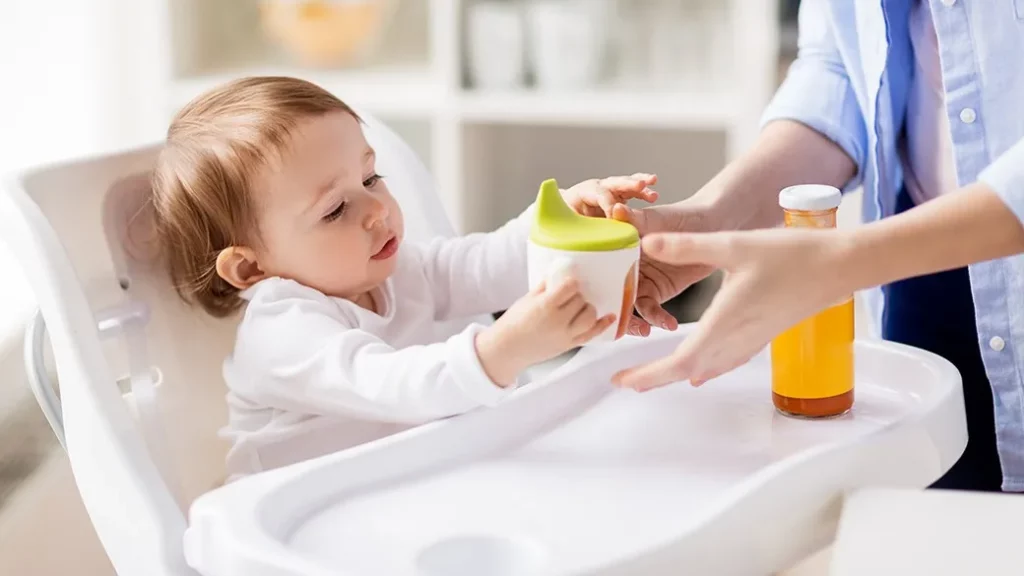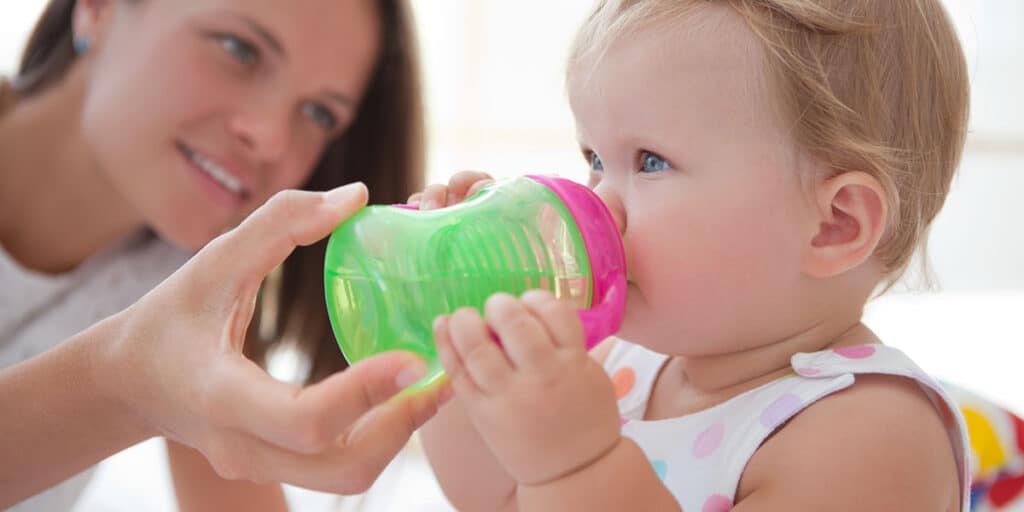Many parents face the challenge of getting their toddlers to drink milk from a sippy cup. While milk is an essential part of a toddler’s diet, some children refuse to drink it from a cup, making it difficult for parents to ensure they are getting all the nutrients they need.
This can be frustrating and worrisome for parents who want to ensure their child’s health and well-being.
Understanding why a toddler may refuse to drink milk from a sippy cup is the first step in finding a solution. There are many reasons why a toddler may resist drinking milk from a cup, including taste preferences, teething, or a dislike of the cup itself.
It is important for parents to be patient and persistent in finding a solution that works for their child.
Key Takeaways
- Understanding the reasons why a toddler may refuse to drink milk from a sippy cup is crucial in finding a solution.
- There are alternatives to milk that can provide the necessary nutrients for a toddler’s diet.
- Consultation with a pediatrician may be necessary if a toddler consistently refuses to drink milk or shows signs of nutritional deficiencies.
Editorial Pick: How To Discipline A Toddler
Understanding Toddlers’ Milk Refusal
Toddlers are notorious for being picky eaters, and this can extend to their choice of beverages as well. Refusal to drink milk from a sippy cup is a common issue that many parents face.
Understanding the reasons behind this behavior can help parents find solutions and ensure that their child is getting the necessary nutrients.
Possible Reasons for Refusal
There are several reasons why a toddler may refuse to drink milk from a sippy cup.
These include:
- Taste preference: Toddlers may prefer the taste of other beverages over milk, or they may simply not like the taste of the milk that is being offered.
- Texture: Some toddlers may not like the texture of milk when it is served in a sippy cup.
- Transitioning: Toddlers who are transitioning from breast milk or formula to cow’s milk may need time to adjust to the new taste.
- Illness: If a toddler is sick or teething, they may refuse to drink milk due to discomfort.
Solutions to Try
There are several solutions that parents can try to encourage their toddler to drink milk from a sippy cup:
- Offer variety: Experiment with different types of milk, such as whole milk, 2% milk, or almond milk. Also, try offering milk at different temperatures or with a flavoring such as vanilla extract.
- Try a different cup: If a toddler doesn’t like the texture of milk in a sippy cup, try a straw cup or an open cup instead.
- Be patient: Toddlers may need time to adjust to the taste of cow’s milk. Gradually introduce it into their diet and offer it alongside their favorite foods.
- Seek advice: If a toddler consistently refuses to drink milk, it may be worth consulting with a pediatrician or a registered dietitian to ensure that they are getting enough nutrients from other sources.
Overall, it is important for parents to be patient and understanding when dealing with a toddler who refuses to drink milk from a sippy cup. By offering variety and experimenting with different cups and techniques, parents can help their child develop a healthy relationship with milk and other beverages.
The Importance of Milk in a Toddler’s Diet
Milk is an essential part of a toddler’s diet as it provides important nutrients that are necessary for their growth and development. It is a rich source of calcium, which is essential for building strong bones and teeth.
Milk also provides other important nutrients such as vitamin D, protein, and fat, which are necessary for a toddler’s overall health.
Calcium is an important nutrient that plays a vital role in the development of strong bones and teeth in toddlers. Milk is an excellent source of calcium and provides around 300mg of calcium per cup.
Toddlers who do not consume enough calcium may be at risk of developing weakened bones and teeth, which can lead to other health problems later in life.
In addition to calcium, milk also contains vitamin D, which helps the body absorb calcium. Vitamin D is important for bone growth and development, and it also plays a role in maintaining a healthy immune system.
Toddlers who do not consume enough vitamin D may be at risk of developing rickets, a condition that causes weak and brittle bones.
Milk is also a good source of protein, which is essential for building and repairing tissues in the body. Toddlers need protein to support their growth and development, and milk provides a high-quality source of protein that is easily digestible.
Finally, milk is a good source of fat, which is important for brain development and function. Toddlers need fat in their diet to support the growth and development of their brain and nervous system.
In conclusion, milk is an important part of a toddler’s diet as it provides essential nutrients such as calcium, vitamin D, protein, and fat. Toddlers who do not consume enough milk may be at risk of developing health problems later in life, so it is important to encourage them to drink milk regularly.
Alternatives to Milk
If your toddler refuses to drink milk from a sippy cup, there are plenty of other options to ensure they receive the necessary nutrients for healthy growth and development.
Here are some alternatives to milk that you can try:
Yogurt and Cheese
Yogurt and cheese are great sources of calcium and protein, which are essential for strong bones and muscles. Choose plain or low-sugar options to avoid added sugars and unnecessary calories.
Greek yogurt is an excellent choice as it contains more protein than regular yogurt.
Salmon
Salmon is rich in vitamin D and omega-3 fatty acids, which are important for brain development and overall health. You can serve it grilled, baked, or canned, depending on your toddler’s preference.
Soy Milk
Soy milk is a popular alternative to cow’s milk and is a good source of protein, calcium, and vitamin D. It is also lactose-free, making it a suitable option for toddlers with lactose intolerance.
Smoothies
Smoothies are a great way to sneak in some extra nutrients into your toddler’s diet. Use a base of milk or yogurt and add fruits and vegetables like spinach, kale, and berries for added vitamins and minerals.
Calcium-Rich Foods
There are plenty of calcium-rich foods that you can incorporate into your toddler’s diet, such as leafy greens like kale and broccoli, and fortified orange juice. Tofu, almonds, and sesame seeds are also excellent sources of calcium.
Chocolate Milk
If your toddler is averse to plain milk, you can try chocolate milk as an alternative. While it does contain added sugars, it is still a good source of calcium and protein.
In summary, there are plenty of alternatives to milk that you can try if your toddler refuses to drink it from a sippy cup. Incorporating a variety of calcium-rich foods into their diet is essential for healthy growth and development.
Transitioning from Bottle to Sippy Cup
Transitioning from a bottle to a sippy cup can be a challenging process for both toddlers and parents. However, it is an important step in a child’s development and should be done gradually to avoid any stress or confusion.
Here are some tips to make the transition as smooth as possible.
Choosing the Right Sippy Cup
When choosing a sippy cup, it is important to consider the type of cup that will work best for your child. There are many different types of sippy cups available, including those with straws, nipples, and open cups.
Here are some factors to consider:
- Material: Choose a sippy cup made of safe materials such as BPA-free plastic, stainless steel, or glass.
- Spout: Some sippy cups have hard spouts, while others have soft spouts that mimic a nipple. Choose a spout that your child is comfortable with.
- Handles: Look for a sippy cup with handles that are easy for your child to grip.
- Size: Choose a sippy cup that is the right size for your child’s age and needs.
Teaching How to Use a Sippy Cup
Once you have chosen the right sippy cup, it is time to teach your child how to use it.
Here are some tips to help your child make the transition:
- Introduce the sippy cup gradually: Start by offering the sippy cup at mealtimes or during snack time.
- Demonstrate how to use the sippy cup: Show your child how to hold the cup and how to drink from it.
- Practice, practice, practice: Encourage your child to practice using the sippy cup regularly.
- Be patient: It may take some time for your child to get used to the sippy cup, so be patient and offer lots of encouragement.
Remember, every child is different, and some may take longer to transition from a bottle to a sippy cup than others. Be patient and keep trying, and eventually, your child will be a big kid using a sippy cup like a pro!
Addressing Lactose Intolerance
For some toddlers, lactose intolerance may be the reason they refuse to drink milk from a sippy cup. Lactose intolerance is a condition where the body is unable to digest lactose, a sugar found in milk and other dairy products.
This can cause discomfort, bloating, and diarrhea, and may lead to a reluctance to consume dairy products.
If a toddler is lactose intolerant, there are a few things parents can do to address the issue. Here are some tips:
-
Try lactose-free milk: Lactose-free milk is a good alternative for toddlers who are lactose intolerant. It has all the nutrients found in regular milk, but without the lactose. It may take some time for a toddler to get used to the taste, so parents should be patient and persistent.
-
Offer dairy alternatives: There are many dairy alternatives available that are rich in calcium and other nutrients. These include soy milk, almond milk, and oat milk. Parents should ensure that the alternative milk they choose is fortified with calcium and vitamin D.
-
Introduce lactase supplements: Lactase is an enzyme that helps the body digest lactose. Lactase supplements are available over-the-counter and can be added to milk or dairy products to help break down lactose. Parents should consult with a pediatrician before giving their toddler any supplements.
-
Gradually increase dairy intake: If a toddler is lactose intolerant, it may be helpful to gradually increase their dairy intake. This can help the body build up tolerance to lactose over time. Parents should start with small amounts of dairy and slowly increase the amount over several weeks.
Overall, lactose intolerance can be managed by making simple dietary changes. Parents should work with their pediatrician to determine the best course of action for their toddler.
Encouraging Toddlers to Drink Milk
Encouraging toddlers to drink milk can be a challenge, especially if they refuse to drink from a sippy cup. Here are some tips to make mealtime more enjoyable and help your toddler get the nutrients they need.
Offer Milk at Mealtime
One way to encourage your toddler to drink milk is to offer it at mealtime. Make sure to include milk as part of their regular meal routine. Offer milk in a cup with a straw or a regular cup with a lid. Try different types of cups to see which your toddler prefers.
Make it Fun
Make drinking milk fun for your toddler. Use a colorful cup or add a fun straw to make it more exciting. You can also add a small amount of chocolate or strawberry syrup to make the milk more appealing.
Be Patient
It may take time for your toddler to get used to drinking milk from a cup. Be patient and keep offering it at mealtime. Try not to force your toddler to drink milk, as this can create a negative association with it.
Offer Other Dairy Products
If your toddler still refuses to drink milk, try offering other dairy products such as cheese or yogurt. These are also good sources of calcium and can help ensure your toddler is getting the nutrients they need.
In conclusion, encouraging toddlers to drink milk can be challenging, but with patience and persistence, it can be done. Offering milk at mealtime, making it fun, and offering other dairy products are all effective ways to help your toddler get the nutrients they need.
Concerns About Tooth Decay
Parents may have concerns about tooth decay when their toddler refuses to drink milk from a sippy cup. Tooth decay is caused by bacteria in the mouth that produce acid, which can erode the enamel of the teeth.
Milk contains lactose, a sugar that can contribute to tooth decay if it is left on the teeth for long periods of time.
When a toddler drinks milk from a sippy cup, the milk can pool in the mouth and coat the teeth, providing a breeding ground for bacteria. If the milk is not brushed away or rinsed out of the mouth, the bacteria can produce acid that can cause tooth decay.
To prevent tooth decay, parents should encourage their toddler to drink water after drinking milk from a sippy cup. This will help to rinse away any milk that may be left in the mouth and reduce the risk of tooth decay.
Parents should also make sure their toddler brushes their teeth twice a day with fluoride toothpaste.
If a toddler continues to refuse to drink milk from a sippy cup, parents can try offering milk in a regular cup or a straw cup. This can help to reduce the amount of milk that pools in the mouth and reduce the risk of tooth decay.
Parents should also talk to their pediatrician or dentist if they have concerns about their toddler’s dental health.
When to Consult a Pediatrician
If a toddler refuses to drink milk from a sippy cup, it can be a cause for concern for parents. While it is common for toddlers to go through phases of picky eating and drinking, there are some instances in which a pediatrician should be consulted.
Here are a few scenarios in which consulting a pediatrician is recommended:
1. Persistent Refusal to Drink Milk
If a toddler persistently refuses to drink milk from a sippy cup or any other cup, it could be a sign of an underlying health issue. A pediatrician can help identify any potential problems and provide guidance on how to address them.
2. Weight Loss or Failure to Thrive
If a toddler is not drinking enough milk or is losing weight, it is important to consult a pediatrician. Failure to thrive is a serious condition that can have long-term effects on a child’s development.
3. Developmental Delays
If a toddler is experiencing developmental delays, it is important to consult a pediatrician. Drinking milk is an important part of a toddler’s diet and can impact their growth and development.
4. Advice on Alternative Sources of Calcium
If a toddler is not drinking milk, a pediatrician can provide advice on alternative sources of calcium. This is important to ensure that the child is getting the nutrients they need for healthy development.
In general, if parents are concerned about their child’s refusal to drink milk from a sippy cup, it is always a good idea to consult a pediatrician. They can provide guidance and support to ensure that the child is getting the nutrients they need for healthy development.
Motor and Swallowing Skills Development
Motor and swallowing skills development are crucial for a toddler’s ability to drink from a sippy cup. At around one year old, most toddlers have developed the necessary motor skills to hold and manipulate a sippy cup.
However, it may take some time for them to develop the coordination and swallowing skills required to drink from it without spilling.
Motor skills refer to a toddler’s ability to use their muscles to perform specific movements. In the case of drinking from a sippy cup, motor skills are required to hold and manipulate the cup, as well as to bring it to their mouth.
Swallowing skills, on the other hand, refer to the ability to swallow liquids without choking or coughing.
It is essential to note that every child develops at their own pace, and some toddlers may take longer to develop these skills than others.
Parents can encourage their child’s development by offering a variety of sippy cups with different shapes and sizes, as well as by providing plenty of opportunities to practice drinking from them.
If a toddler is struggling to drink from a sippy cup, it may be helpful to consult with a pediatrician or a feeding specialist. They can provide guidance on how to support the child’s development and ensure that they are getting the necessary nutrition.
Frequently Asked Questions
What to do if my toddler won’t drink milk from a sippy cup?
If your toddler won’t drink milk from a sippy cup, try offering milk in a regular cup or bottle instead. You can also try different types of sippy cups with different spout shapes and sizes to see if your toddler prefers a certain type.
It’s important to make sure your toddler is still getting enough calcium and vitamin D from other sources if they are not drinking milk.
How can I transition my toddler from a bottle to a sippy cup for milk?
To transition your toddler from a bottle to a sippy cup for milk, start by introducing the sippy cup during meal times and offering it alongside the bottle. Gradually decrease the amount of milk in the bottle and increase the amount in the sippy cup until your toddler is comfortable drinking from the sippy cup alone.
What are some tips for encouraging my toddler to drink milk from a sippy cup?
Some tips for encouraging your toddler to drink milk from a sippy cup include offering milk in a fun and colorful cup, letting your toddler choose their own cup, and offering milk at different temperatures to see what your toddler prefers.
You can also try adding a small amount of flavoring, such as a drop of vanilla extract or a pinch of cinnamon, to make the milk more appealing.
Why might my toddler suddenly refuse to drink milk from a sippy cup?
There are several reasons why a toddler might suddenly refuse to drink milk from a sippy cup, such as teething, illness, or a change in routine. It’s important to offer other sources of calcium and vitamin D if your toddler is not drinking milk, and to talk to your pediatrician if you are concerned.
When should I start introducing a sippy cup for milk to my baby?
It’s generally recommended to start introducing a sippy cup for milk around 6-9 months of age, when your baby is able to sit up and hold a cup. However, every baby is different, so it’s important to follow your baby’s cues and introduce the sippy cup when they are ready.
What are some recommended sippy cups for toddlers who won’t drink milk?
Some recommended sippy cups for toddlers who won’t drink milk include cups with soft spouts, cups with handles for easy gripping, and cups with spill-proof valves to prevent messes. It’s important to choose a cup that your toddler is comfortable with and that meets their individual needs.
Related Post: How Long to Microwave Milk?

Iesha is a loving mother of 2 beautiful children. She’s an active parent who enjoys indoor and outdoor adventures with her family. Her mission is to share practical and realistic parenting advice to help the parenting community becoming stronger.



